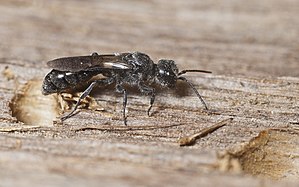Pemphredon
| Pemphredon | ||||||||||||
|---|---|---|---|---|---|---|---|---|---|---|---|---|

Pemphredon sp. |
||||||||||||
| Systematics | ||||||||||||
|
||||||||||||
| Scientific name | ||||||||||||
| Pemphredon | ||||||||||||
| Latreille , 1796 |
Pemphredon is a genus of digger wasps (Spheciformes) from the Crabronidae family. The genus is distributed holarctic , 12 species are represented in Europe. Several species areconsidered beneficial insectsbecause of their specialization in aphids .
features
The Pemphredon species are often small and black in color and have some resemblance to ants . They have a short, furrowed abdomen, two submarginal cells in the fore wing and a head that is well developed, especially behind the compound eyes. Species identification is difficult.
Based on the course of the submarginal veins, the genus is divided into three groups of species, which some authors also consider sub-genera. These are the lugubris , morio , and lethifer groups. In the former, the outer vein of the second submarginal cell meets the marginal cell noticeably below the center and the second return vein ends in the second submarginal cell. This is usually longer than it is high. In the morio group, the outer vein meets the marginal cell in the middle and the second submarginal cell is higher than it is long. Another feature of this group is a small thorn between the antennae. In the third group, the outer vein meets the marginal cell near the middle, but the second returning vein ends in front of or just short of the second submarginal cell, which is usually as long or longer than it is high.
Way of life
The females usually create their nests in hollow or medullary stems or twigs. Some species also use abandoned feeding channels in the wood or create their nests in plant galls. If there is not enough space, the cells are laid out in lines, otherwise they are branched out. Short side passages are often first filled with drilling dust and only later expanded into cells. The cell walls consist of nailed rods. Each cell is provided with 10 to 60 green aphids , the selection of the species being unspecific. The prey is either stabbed or killed with the mandibles. Then they are packed with the mandibles and transported to the nest. When a cell is fully supplied, an egg is deposited on the bottom or in the middle of the cell between the prey animals. In many species, the pupation of the larvae does not take place in a complete cocoon , but in a cap over the head, which can merge as a thin membrane into the wall of the brood cell. Some species such as Pemphredon lethifer also make a fine second membrane just below the cap.
Females usually hatch from the inner cells of the nest and males from the outer cells. The genus develops proterandrically , which means that the males hatch a few days before the females. In Central Europe, one generation is trained per year, in favorable years it can be two. The Imagines of many species feed on honeydew , but sometimes also by aphids themselves. Parasitoids of the genus are from wasps , parasitic wasps , gout wasps (Gasteruptionidae) and chalcids proven.
Species (Europe)
- Pemphredon austriaca (Kohl 1888)
- Pemphredon baltica Merisuo 1972
- Pemphredon beaumonti Hellen 1955
- Pemphredon flavistigma Thomson 1874
- Pemphredon inornata Say 1824
- Pemphredon lethifer (Shuckard 1837)
- Pemphredon lugens Dahlbom 1842
- Pemphredon lugubris (Fabricius 1793)
- Pemphredon montana Dahlbom 1845
- Pemphredon morio Vander Linden 1829
- Pemphredon podagrica Chevrier 1870
- Pemphredon rugifer (Dahlbom 1844)
supporting documents
Individual evidence
- ↑ a b c d e Manfred Blösch: The digger wasps in Germany: way of life, behavior, distribution . 1st edition. Goecke & Evers, 2000, ISBN 3-931374-26-2 , pp. 167 f .
- ↑ Pemphredon. Fauna Europaea, accessed July 25, 2010 .